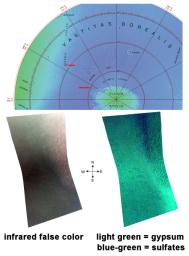
|
Gypsum Dunes North of Phoenix Landing Site
- Click the image above for a larger view
- Full-Res JPEG (1109 x 1500) (202.4 kB)
- Full-Res TIFF (1109 x 1500) (5.0 MB)
Caption:
This image of sulfate deposits, including gypsum, in the Olympia Undae region of Mars was taken by the Compact Reconnaissance Imaging Spectrometer for Mars (CRISM) at 0026 UTC on November 18, 2006 (7:26 p.m. EDT on November 17, 2006) near 80 degrees north latitude, 245 degrees east longitude. CRISM's image was taken in 544 colors covering 0.36-3.92 micrometers, and shows features as small as 20 meters (66 feet) across.
Named for a classic albedo feature, Olympia Undae is a large dune field that stretches some 1,100 kilometers (684 miles) across the northern polar regions of Mars, just south of the ice cap.
In 2005 CRISM's sibling instrument, OMEGA, on board Mars Express, captured data revealing that Olympia Undae's dunes hold sulfate minerals including gypsum. With more than five times the spatial resolution of OMEGA, CRISM has captured greater detail of this region.
The top image reveals the location of CRISM data on a Mars Orbiter Laser Altimeter (MOLA) map. The area from which CRISM data were gathered is roughly 12 degrees north and 11 degrees east of the region where Phoenix recently landed.
The lower left image is an infrared, false-color image that reveals dark colored dunes overlying a lighter, rust-colored substrate. CRISM spectral data (lower right image) shows the region is inundated with sulfates. It also reveals that the darker dune material holds a higher concentration of the water-bearing calcium sulfate mineral gypsum. A full resolution targeted CRISM image taken just five degrees west of the image above, revealed greater gypsum concentrations along the dunes' crests ( Gypsum at Olympia Undae ).
On Earth, gypsum is the most common sulfate mineral and is widely found in sedimentary rocks. It's frequently associated with evaporite salts and is often found as a thick layer beneath halite or rock salt. Although most often associated with evaporites, gypsum can also occur in layers with limestone and shale. Most people are familiar with gypsum in the form of plaster of Paris.
Background Info:
CRISM is one of six science instruments on NASA's Mars Reconnaissance Orbiter. Led by The Johns Hopkins University Applied Physics Laboratory, Laurel, Md., the CRISM team includes expertise from universities, government agencies and small businesses in the United States and abroad. NASA's Jet Propulsion Laboratory, a division of the California Institute of Technology in Pasadena, manages the Mars Reconnaissance Orbiter and the Mars Science Laboratory for NASA's Science Mission Directorate, Washington. Lockheed Martin Space Systems, Denver, built the orbiter.
Cataloging Keywords:
| Name | Value | Additional Values |
|---|---|---|
| Target | Mars | |
| System | ||
| Target Type | Planet | |
| Mission | Mars Reconnaissance Orbiter (MRO) | Mars Express, Mars Express (MEX), Mars Science Laboratory (MSL), Phoenix |
| Instrument Host | Mars Reconnaissance Orbiter | Curiosity Rover, Mars Express, Mars Express Orbiter, Phoenix Lander |
| Host Type | Orbiter | Lander, Rover |
| Instrument | Compact Reconnaissance Imaging Spectrometer for Mars (CRISM) | Visible and Infrared Mineralogical Mapping Spectrometer (OMEGA) |
| Detector | ||
| Extra Keywords | Color, Dune, Infrared, Map, Water | |
| Acquisition Date | ||
| Release Date | 2008-05-30 | |
| Date in Caption | 2006-11-17 | 2006-11-18 |
| Image Credit | NASA/JPL/JHUAPL/ASU/USGS | |
| Source | photojournal.jpl.nasa.gov/catalog/PIA10946 | |
| Identifier | PIA10946 | |
